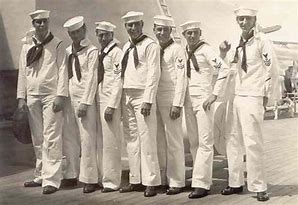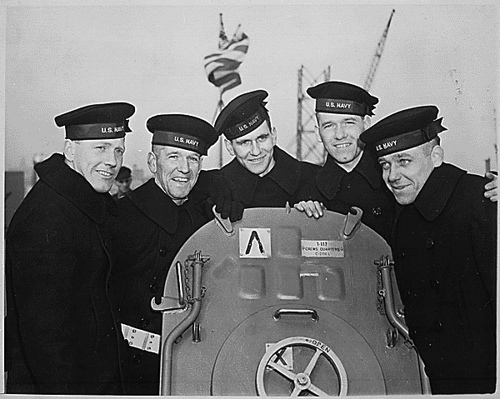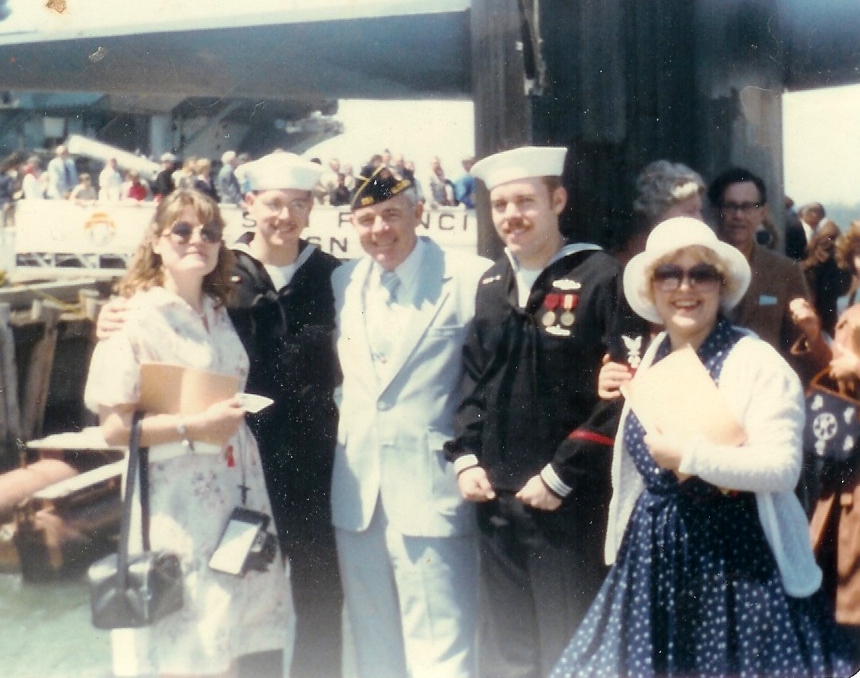As it so often happens, I was looking through the archives and discovered an article that jumped off the pages at me. This article was found in a collection of Navy Department News Releases and was released seventy seven years ago today (September 7, 2018)
NAVY DEPARTMENT
HOLD FOR RELEASE
SUNDAY PAPERS, SEPTEMBER 7, 1941
FATHER TO JOIN SEVEN SONS IN THE U. S. NAVY
A sea meeting unique in the world’s naval history will take place on the quarterdeck of the USS NEVADA on Tuesday night with the central figure, strangely enough, a farmer from Ridgefield, Washington. Officers and crew of the big battleship drawn up at rigid attention for the impressive rite, Captain F. W. Scandland, U. S. Navy, the NEWADA’s commanding officer, will administer the Navy enlistment oath to the farmer– Clarence Floyd Patten, a man of about 50 years.
Standing just behind the principal in the ceremony, in which Secretary of the Navy Frank Knox in Washington will take part by radio, will be seven proud Sailors–Patten’s sons, Clarence, Jr., Myrne, Roy, Marvin, Allen, Gilbert and Bruce, all serving in the NEVADA’s fireroom. The elder Patten, not to be outdone by his sons, decided some time ago to follow the same urge which led them to the sea and into the service of their country and he will be enlisted as a fireman, first class.
Nor is the father the last of the Patten family who will enter the Navy. An eighth son, Wayne Henry Patten, just 16, about to become a sophomore at a Portland (Oregon) High School and with aspirations to become an aviator, plans to enlist when he becomes eligible on July 1, 1942. The NEVADA’s location for the ceremony will remain secret for reasons of Navy security, but the public will be enabled to hear the rites through the facilities of the National Broadcasting Company, which is to present it over its Blue Network from 7:00 to 7:15 p.m. Eastern Standard Time.
Secretary Knox will congratulate the elder Patten on the patriotism of his all-Navy family in a brief talk over a special hook-up linking Washington, D.C., with the NEVADA. All of the Patten brothers were born at Lake City, in Carroll County, Iowa, and the first to enter the Navy was Clarence Floyd Patten, Jr., now 25, who enlisted on July 1, 1937. The next was Myrne Roosevelt Patton, 22, who enlisted October 5, 1937.
Roy Hart Patten, 20, enlisted November 21, 1939; Marvin Kenneth Patten, 28, on January 3, 1940, exactly two weeks ahead of Allen Mayo Patten, 24; Gilbert Russell Patten, 29, on August 31, 1940, and Bruce Calvin Patten, 18, on December 12, 1940. Clarence, Myrne, Roy and Marvin all enlisted at Des Moines, Iowa; Allen at San Diego, California; Gilbert in Honolulu, T.H., and Bruce at Portland, Oregon.
In keeping with the Navy’s policy to bring together, whenever possible, brothers in the service, the seven Patten boys were put together in the NEVADA. In fact, all of them are stationed in the fireroom and occupy seven bunks together in a corner of one of the ship’s sleeping compartments.
(Photograph available in Photographic Section, Office of Public Relations.)
The Nevada wasn’t in her usual place when the Japanese attacked Pearl Harbor just a few month later. During the previous fleet maneuvers, she was delayed coming into port and the USS Arizona took her usual berth. This left the Nevada outboard of another ship and able to get underway once the attack occurred.
USS Nevada (BB-36), eldest (by a few months) of the battleships in Pearl Harbor on 7 December 1941, was hit by one torpedo during the last part of the Japanese torpedo planes’ attack. This opened a large hole in the ship’s port side below her two forward turrets. Her anti-torpedo protection, of a type back-fitted to the Navy’s older battleships, resisted the warhead’s explosion fairly well. However, serious leaks were started in the inmost bulkhead, allowing a considerable amount of water into the ship.
The damaged Nevada got underway at 0840, about a half-hour after she was torpedoed, backed clear of her berth, and began to steam down the channel toward the Navy Yard. The slowly moving battleship was an attractive target for Japanese dive bombers, which hit and near-missed her repeatedly, opening up her forecastle deck, causing more leaks in her hull, starting gasoline fires forward and other blazes in her superstructure and midships area. Now in serious trouble, Nevada was run aground on the Navy Yard side of the channel, just south of Ford Island.
As her crew fought her many fires, the ship twisted around until she was facing back up the harbor. With the help of tugs, Nevada then backed across the way and grounded, stern-first, on the other side of the channel. Her old, much-modified structure proved itself to be anything but watertight, and water traveled inexorably throughout the ship. By the following day, she had settled to the bottom, fortunately in fairly shallow water. There she was to remain for over two months, the subject of one of the first of Pearl Harbor’s many demanding salvage projects.
Over the course of the morning, Nevada suffered a total of 60 killed and 109 wounded. Two more men died aboard during salvage operations on 7 February 1942 when they were overcome by hydrogen sulfide gas from decomposing paper and meat. The ship suffered a minimum of six bomb hits and one torpedo hit, but “it is possible that as many as ten bomb hits may have been received, […] as certain damaged areas [were] of sufficient size to indicate that they were struck by more than one bomb
None of the Patten Family were listed as KIA in the attack. You can find the rest of their amazing story here:
http://www.pearlharborsurvivorsonline.org/html/USS20Nevada20Patten20Brothers.htm
The Sullivan’s were not so fortunate
Just over a year later, the Navy’s policy on allowing family to be stationed together received a shocking jolt when the USS Juneau was sunk at the Naval Battle for Guadalcanal. The famous “Fighting Sullivan Brothers would all lose their lives in a single day.
The Navy would not allow brothers and family to serve again for many generations. Interesting footnote: forty years later (1981) My brother Tom and I both served on the USS San Francisco SSN 711 for over three years together. During that time, the 711 boat would be host to a total of four sets of brothers.
To the best of my knowledge, we all made it home safely. Interestingly enough, my brother Tom went on to serve on the Submarine USS Nevada.
I have often thought that the world was filled with a number of randomly colliding coincidences.





Reblogged this on Tales of an Asia Sailor.
Reblogged this on Dave Loves History.
I don’t think there are coincidences.